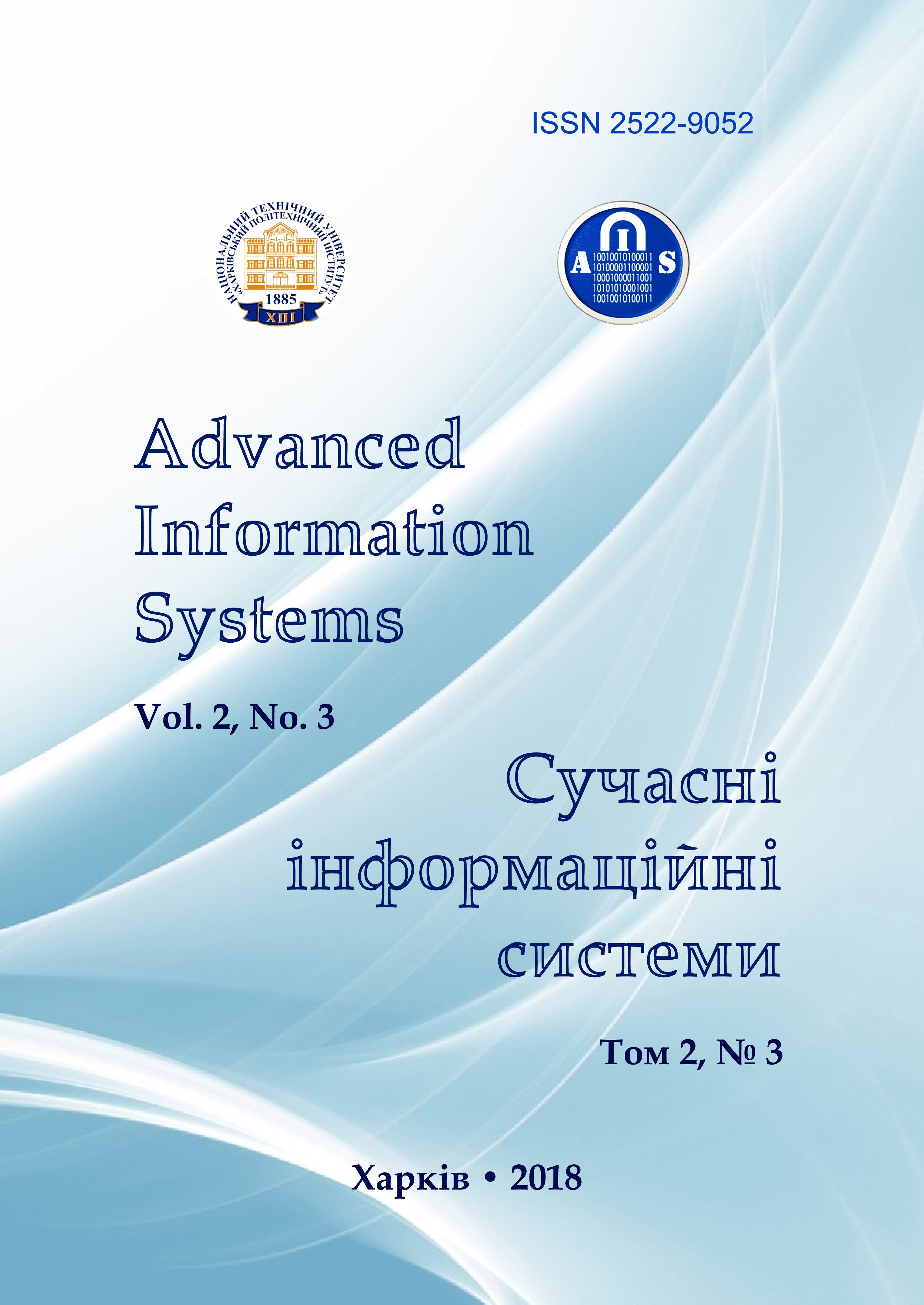Architecture synthesis of the computer system of transaction control e-learning
Main Article Content
Abstract
The paper deals with the problem of synthesizing the architecture of a modern computer system for managing e-learning transactions. The purpose of the article is the development of a decomposition method for the synthesis of the architecture of the computer system of transaction management e-learning based on the stratification of the oriented graph of options for implementation of the computer system. Research results. The main stages of the synthesis of architecture are analyzed. The main stages of the synthesis of architecture are analyzed. The necessity of the preliminary decomposition, structuring and formalization of the system is substantiated. The main stages of the hierarchical sequence of the decomposition process are given. Developed by the deck is a positional method for synthesizing a computer system architecture based on the stratification of an oriented graph of options for implementing a computer system. A simulation model of this process has been developed. The results of the simulation showed the feasibility of applying the developed method in the synthesis of the architecture of a computer system with a large number of nodes. Conclusions/ The paper considers the problem of synthesis of the architecture of a modern computer system for managing a complex distributed object. The main stages of the synthesis of architecture are analyzed. The necessity of preliminary decomposition, structuring and formalization of the system is substantiated. The main stages of the hierarchical sequence of the decomposition process are presented. A decomposition method is synthesized for the architecture of a computer system based on the stratification of a focused graph of the implementation options of the COP. The simulation model of this process is developed. The simulation results showed the expediency of applying the developed method to the synthesis of the architecture of a computer system with a large number of nodes. Thus, at N < 60 the application of this method is not practical. With the number of nodes COP 60 < N <100, no practical gain in time for synthesis is not achieved. However, at N > 100 the winning becomes noticeable. Moreover, with the increase in the number of nodes, the advantage of the decomposition method increases.
Article Details
References
Shmatkov, S.I., Kuchuk, N.G. and Donets, V.V. (2018), “Model of information structure of the hyperconvergent system of support of electronic computing resources of university e-learning”, Control systems, navigation and communication, Poltava, No. 2 (48), pp. 97-100.
Donets, V., Kuchuk, N. and Shmatkov, S. (2018), “Development of software of e-learning information system synthesis mod-eling process”, Advanced Information Systems, Vol. 2, No. 2, pp. 117-121.
Hamed, Dinari (2017), “A Survey on Graph Queries Processing: Techniques and Methods”, International Journal of Comput-er Network and Information Security (IJCNIS), Vol. 9, No. 4, pp. 48-56, available at:
http://dx.doi.org/10.5815/ijcnis.2017.04.06.
Olifer, V.G., Olifer, N.A. (2012), Computer Networks. Principles, Technologies, Protocols, (4th Edition), St.Petersburg : Piter, 943 p.
Kuchuk, G.A., Akimova, Yu.A. and Klimenko, L.A. (2000), “Method of optimal allocation of relational tables”, Engineering Simulation, Vol. 17, pp. 681-689.
Gelenbe, E. and Pujolle, G. (2010), “Analysis and Synthesis of Computer Systems”, Advances in Computer Science and Engi-neering, Texts. Vol. 4, 309 p.
Merlac, V., Smatkov, S., Kuchuk, N. and Nechausov A. (2018), “Resourses Distribution Method of University e-learning on the Hypercovergent platform”, Сonference Proceedings of 2018 IEEE 9th International Conference on Dependable Systems, Service and Technologies. DESSERT’2018, Ukraine, Kyiv, May 24-27, pp. 136-140, available at:
http://dx.doi.org/ 10.1109/DESSERT.2018.8409114.
Nina Kuchuk; Oleksandr Mozhaiev; Mykhailo Mozhaiev and Heorgii Kuchuk (2017), “Method for calculating of R-learning traffic peakedness”, 2017 4th International Scientific-Practical Conference Problems of Infocommunications Science and Tech-nology, PIC S and T 2017 – Proceedings, pp. 359 – 362, available at:
http://dx.doi.org/10.1109/INFOCOMMST.2017.8246416.
Mukhin, V., Romanenkov, Yu., Bilokin, Ju., Rohovyi, A., Kharazii, A., Kosenko, V., Kosenko, N. and Su Ju. (2017), “The Method of Variant Synthesis of Information and Communication Network Structures on the Basis of the Graph and Set-Theoretical Models”, International Journal of Intelligent Systems and Applications (IJISA), Vol. 9, No. 11, pp.42-51. available at:http://dx.doi.org/ 10.5815/ijisa.2017.11.06
Kovalenko, A.A., Kuchuk, G.A. (2018) “Current state and trends of development of computer systems of objects of critical application”, Control, navigation and communication systems. – PNTU, Poltava, No. 1 (47), pp. 110-113.
Mozhaev, O., Kuchuk, H., Kuchuk, N., Mykhailo, M. and Lohvynenko, M. (2017), “Multiservice network security metric”, 2nd International Conference on Advanced Information and Communication Technologies, – Proceedings, pp. 133-136.
Kosenko, V.V. and Kuchuk, N.G. (2016), “Modeling of Technical Information and Telecommunication Network Based on its Particular Implementation of Information”, Information Processing Systems, Ivan Kozhedub Kharkiv National Air Force Uni-versity, Kharkiv, No. 9 (146), pp. 167-171.
Ayodeji, J. Akande, Colin, Fidge and Ernest, Foo (2017), “Limitations of Passively Mapping Logical Network Topologies”, International Journal of Computer Network and Information Security (IJCNIS), Vol. 9, No. 2, pp.1-11, 2017, available at: http://dx.doi.org/10.5815/ijcnis.2017.02.01.
Zhang, M. Hu, and Yang J. (2007), “TreePi: A Novel Graph Indexing Method”, IEEE 23rd International Conference on Data Engineering, Istanbul, pp. 966-975.
Kuchuk, G., Kharchenko, V., Kovalenko, A., Ruchkov, E. (2016), “Approaches to Selection of Combinatorial Algorithm for Optimization in Network Traffic Control of Safety-Critical Systems”, Proceeding of IEEE East-West Design & Test Symposium (EWDTS’2016), pp. 384-389, 2016, available at: http://dx.doi.org/10.1109/EWDTS.2016.7807655.
Kuchuk, G.A., Gakhov, R.P. and Pashnev A.A. (2006), Infocommunication Resources Management, Fizmatlit, Moscow, 220 p.
Xifeng, Yan, Philip S.Yu. and Han J. (2004), “Graph indexing: a frequent structure-based approach”, ACM SIGMOD interna-tional conference on Management of data, pp. 335-346.
